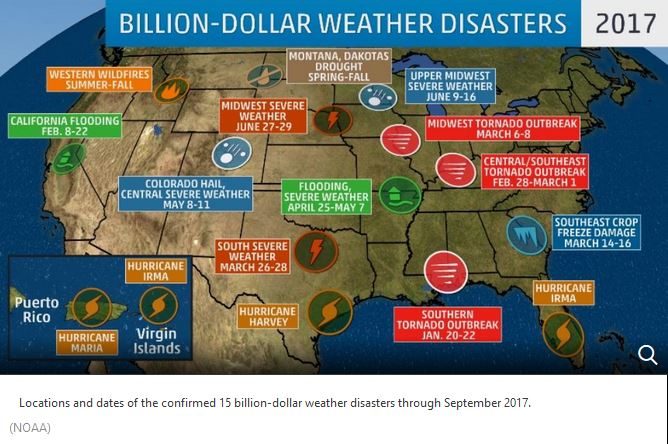
© The Weather Channel (screen capture)
A new record for the number of billion-dollar natural disasters in the United States may be set this year, with 15 such events already confirmed through September.
There were
12 billion-dollar weather disasters that began during the first half of 2017, and hurricane season has brought three storms that resulted in massive damage, including
Harvey,
Irma and
Maria. The official damage costs are not available yet for these storms but are expected to be billion-dollar weather disasters, according to NOAA's National Centers for Environmental Information (NCEI).
Tornado and severe thunderstorm events have made up the largest share and have added seven billion-dollar weather disasters to the list.
Two flooding events are also on the list: one in Missouri and Arkansas in late April early May and one in California in February. On the other side of the precipitation spectrum, the ongoing drought in Montana and the Dakotas has already reached more than $2 billion.
Rounding out the list is the severe March freeze in the Southeast that was preceded by unusually warm temperatures, resulting in $1 billion in damage to crops, and the wildfires in the Northwest.
In addition to the economic impact, these 15 events have resulted in the deaths of nearly 300 people.
Through September, 2017 is now tied with 2016 for the second-most billion-dollar disasters in a year, according to NOAA's database, which dates back to 1980. The year with the highest number of billion-dollar weather disasters is 2011, which had 16.

© The Weather Channel (screen capture)
If the October
California wildfires or
Hurricane Nate's costs reach the $1 billion threshold, 2017 could set a new record for highest number of billion-dollar disasters in a single year. This record could also be set if any additional billion-dollar disasters take place and are confirmed through December.
The increase in billion-dollar disasters is due, in part, to the increase in population and material weather over the last several decades. NCEI notes many population centers exist in vulnerable areas where "building codes are often insufficient in reducing damage from extreme events." The increasing frequency of some types of extreme weather due to climate change
is also a factor, according to the report from NCEI.
Since 1980, there have been 218 weather and climate disasters in the U.S. that have reached at least $1 billion in damage or cost. The total cost of these 218 events exceeds $1.2 trillion. This cost, however, does not include Harvey, Irma and Maria.
Interestingly, NCEI said tropical cyclones are, on average, the most costly per event ($16.7 billion), followed by droughts ($9.4 billion). Tropical cyclones account for about 17 percent of the total number of events but have caused about 47 percent of the total damage attributed to billion-dollar weather disasters since 1980. These numbers are expected to rise dramatically once the 2017 hurricane costs are included.
The current costliest U.S. weather disaster in the
NCEI's database since 1980, adjusted for inflation, is Hurricane Katrina at $161.3 billion.


Comment: As well as the financial cost, the psychological toll of natural disasters needs to be considered also. See also:
New FEMA Director calls for Americans to develop "a true culture of preparedness" - but no one is listening